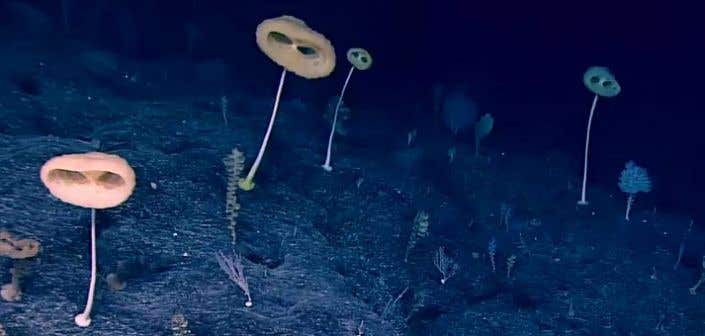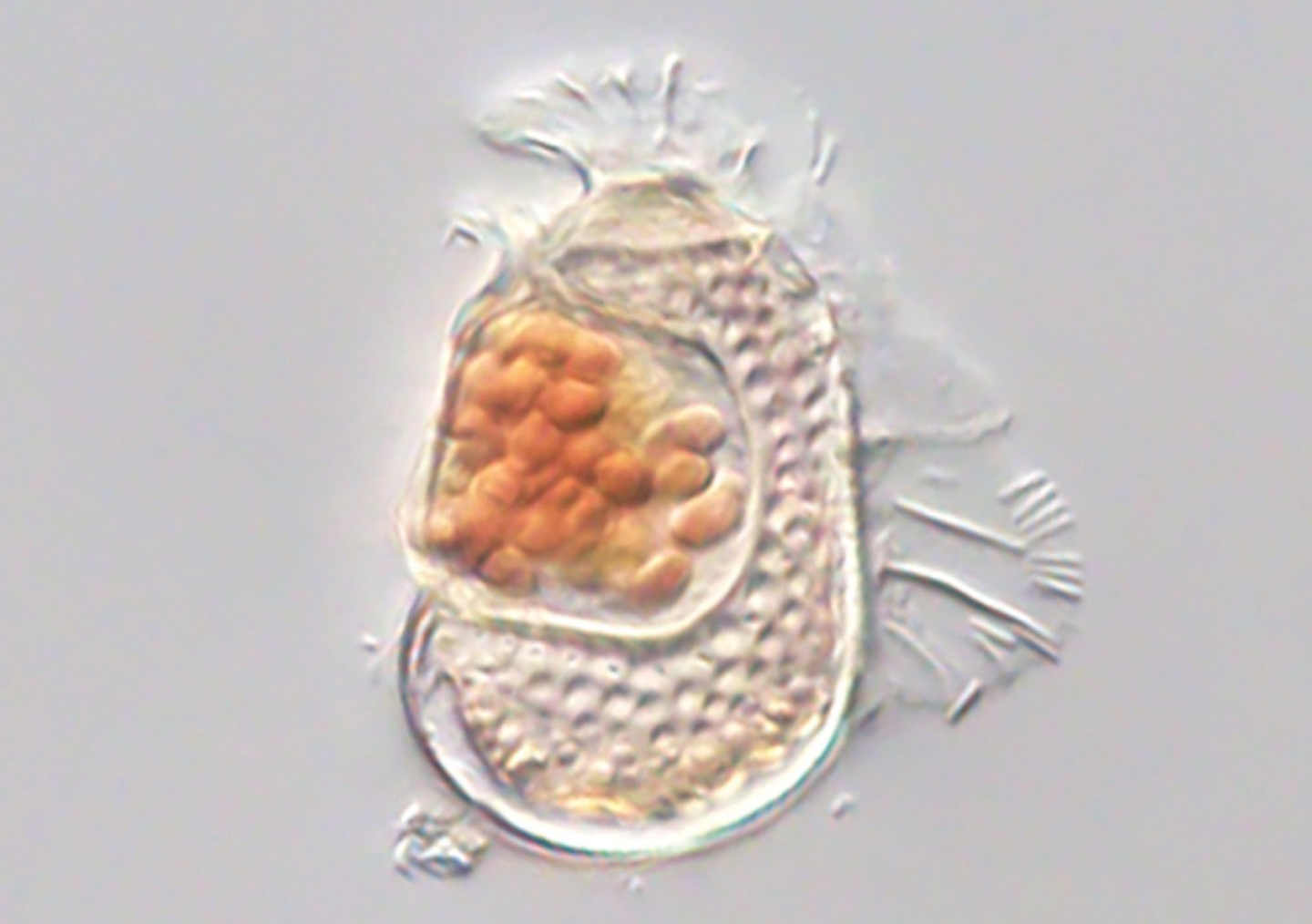A Magnificent, ET Like, New Sponge from the Deep Gets a Name
[July 10, 2020: NOAA] In a newly published paper , scientists have identified and named a new genus and species of sponge: Advhena…

[July 10, 2020: NOAA]
In a newly published paper , scientists have identified and named a new genus and species of sponge: Advhena magnifica, Latin for “magnificent alien.” This new sponge was sampled and seen during missions in the Pacific on NOAA Ship Okeanos Explorer. Read on to learn more about this discovery.
On July 25, 2017, while exploring a seamount nearly 850 miles southwest of Hawai'i during an expedition led by the NOAA Office of Ocean Exploration and Research on NOAA Ship Okeanos Explorer, a team of deep-ocean explorers came upon an extraordinary seascape. Dr. Chris Mah of the Smithsonian National Museum of Natural History (NMNH) dubbed the scene the “Forest of the Weird” due to the diversity of prominent sponges rising up on stalks with their bodies oriented to face the predominant current carrying tiny food particles.
Among the different sponges within this alien-like community was one that could not be missed. Rising high on a stalk, this sponge had a body with two large holes oddly reminiscent of the large eyes of the alien from the beloved movie, E.T.: The Extra-Terrestrial.
Turns out that this wasn’t the first time that scientists exploring via Okeanos Explorer had encountered this unusual sponge. In 2016, while exploring a seamount just east of the Mariana Trench, a sample of the sponge had been collected. The collected sample was sent to the NMNH for long-term care and study by researchers, setting the stage for this exciting—and charismatic—discovery.
We caught up with Dr. Cristiana Castello Branco, a postdoctoral researcher, who made the discovery of the “E.T. sponge.” Cristiana is working under the guidance of Dr. Allen Collins, Director of the NOAA Fisheries National Systematics Laboratory located at NMNH.
Cristiana prepares to enter a Curasub submersible for a dive. At the time of the sponge discovery, Cristiana was a Ph.D. student at NMNH being supervised by NOAA Fisheries’ Dr. Collins. Image courtesy of Cristiana Castello Branco.
How did you know you’d found a new type of sponge?
It is a long process between when we first see a specimen and when we can give it a name. While we know very little about deep-sea sponges, we do know they are very abundant, so chances are often good that we will find new species. But to know you found a new one, you need to analyze the skeletal elements of the sponge, called spicules, in the lab using powerful microscopes. The types of spicules and how they are organized in the body vary across different types of sponges, and the spicules are what we use to make identifications. But on top of that, we have to compare what we see to all the known species of a particular genus to find out if it is known or new to science.
For the “E.T. sponge,” I had started my studies with Allen and Eduardo (Dr. Eduardo Hajdu) by analyzing some specimens from the Atlantic region. I also decided to examine specimens from other parts of the world that were closely related to taxa I was describing in my thesis. Among these samples, I found a couple representatives of the glass sponge family Bolosomidae, including a big and beautiful sponge with an alien-shaped body. At first, I thought it would be a new species of Bolosoma (a genus I’d been working on during my thesis). Once I began to examine the sponge’s spicules, however, I realized that they were not the same as those from any known species.
How did you choose the scientific name, Advhena magnifica, for this new sponge?
The scientific name for a new animal is always Latin or Greek. We usually try to associate the name to something unique about that species, or we can honor someone, the expedition name, or a locality. In the case of Advhena magnifica, the shape of this sponge is reminiscent of an alien, like in the movies, with what looks like a long thin neck, an elongated head, and huge eyes. Advhena is from the Latin advena, which means alien, but in the sense of visitor, foreigner, or immigrant, although we (humans) were the actual visitors to the sponge’s deep-sea home when we found this “magnificent alien.” While we haven’t “officially” given it a common name in our paper, “E.T. sponge” seems to fit.
Like all biologic samples collected during Okeanos Explorer expeditions, the “E.T. sponge” collected in 2016 was archived in the collections of the National Museum of Natural History, Smithsonian Institution. In this image of the collected sample, the two holes of the sponge that give it an alien appearance are clearly visible. These holes, termed oscules, serve as openings out of which the sponge pumps water. The sponge is covered in even tinier pores where the water is drawn into the sponge. Bacteria and other small prey are captured in small chambers and the water is pumped out through a complex of canals and ultimately straight out of the oscules. Image courtesy of NMNH
What is the significance of discovering a new genus and species?
Discovering new species of deep-sea sponges is fairly common, and while the group is very diverse, we still know very little about it. We don’t even know how many species we still have to discover in the deep ocean, but it is a big number. So, chances for new discoveries are good.
When we find a new genus or species, we are helping to describe our planet’s marine biodiversity, which refers to the variety of living organisms in the ocean, from bacteria and fungi to invertebrates and fish, all the way to marine mammals and birds. As all of these organisms are intricately connected, by documenting and describing marine biodiversity, we are building a better understanding of life and the impact of humans on Earth (in this case, in the ocean).
Also, a description of a new genus just emphasizes how little we know about the deep sea and deep-sea sponges.
What role does the newly discovered sponge play in the ecosystem?
Sponges are one of the most diverse and abundant groups of organisms on the bottom of the ocean, and they have huge impacts in the marine ecosystem. Many are large and provide structure in and around which other organisms live. Sponges are filter-feeding animals capable of maintaining the balance of micro flora and fauna and play important roles in the ocean’s nitrogen and carbon cycles. As sessile (attached) animals, they defend themselves by producing chemical compounds that may be useful in treating human diseases. As such, the study of deep-sea sponge biodiversity provides a necessary basis for future environmental management decisions as well as bioprospecting studies.
The glass sponge, Advhena magnifica, prior to being collected in 2016 at a depth of ~2,000 meters (6,560 feet). Scientists call this class of sponges “glass sponges” (class Hexactinellida) because their skeletons are made of silica (glass). Their bodies contain fascinating tissues that consist of many nuclei within a single membrane, and these tissues help conduct electrical signals across the sponge making them able to respond quickly to external stimuli. Image courtesy of the NOAA Office of Ocean Exploration and Research, 2016 Deepwater Exploration of the Marianas
How did you get into this line of work? Do you have any advice for young people interested in being a zoologist who discovers new species?
When I was an undergrad, I started to work with sponges as an intern at Universidade Federal da Bahia in Brazil. It was an opportunity to work on the scientific collection of the university, and I fell in love with sponges then. After that, I followed with a master’s degree and then I studied deep-sea sponges during my Ph.D. work at Museu Nacional, Universidade Federal do Rio de Janeiro.
As for advice for young people, apply for internships and try to figure out what most gets your attention and love. It is not that easy, but as long as you are doing what you really enjoy, it is worth it.
Joseph Shavit
Head Science News Writer | Communicating Innovation & Discovery
Based in Los Angeles, Joseph Shavit is an accomplished science journalist, head science news writer and co-founder at The Brighter Side of News, where he translates cutting-edge discoveries into compelling stories for a broad audience. With a strong background spanning science, business, product management, media leadership, and entrepreneurship, Joseph brings a unique perspective to science communication. His expertise allows him to uncover the intersection of technological advancements and market potential, shedding light on how groundbreaking research evolves into transformative products and industries.



